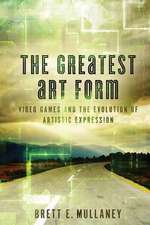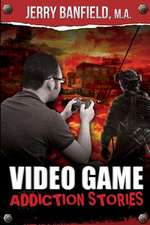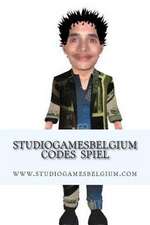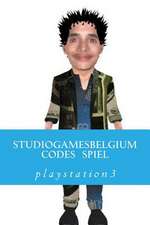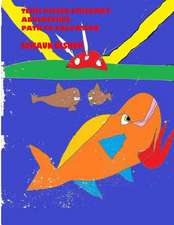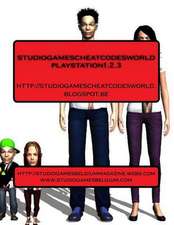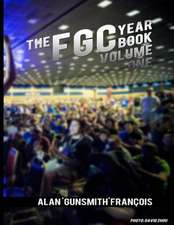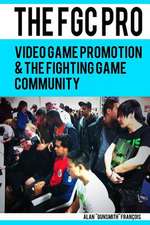Procedural Generation in Game Design
Editat de Tanya Short, Tarn Adamsen Limba Engleză Paperback – iun 2017
Key Features:
- Introduces the differences between static/traditional game design and procedural game design
- Demonstrates how to solve or avoid common problems with procedural game design in a variety of concrete ways
- Includes industry leaders’ experiences and lessons from award-winning games
- World’s finest guide for how to begin thinking about procedural design
Preț: 387.72 lei
Nou
Puncte Express: 582
Preț estimativ în valută:
74.20€ • 76.99$ • 62.02£
74.20€ • 76.99$ • 62.02£
Carte tipărită la comandă
Livrare economică 15-29 martie
Preluare comenzi: 021 569.72.76
Specificații
ISBN-13: 9781498799195
ISBN-10: 1498799191
Pagini: 336
Ilustrații: 107
Dimensiuni: 156 x 234 x 21 mm
Greutate: 0.54 kg
Ediția:1
Editura: CRC Press
Colecția A K Peters/CRC Press
ISBN-10: 1498799191
Pagini: 336
Ilustrații: 107
Dimensiuni: 156 x 234 x 21 mm
Greutate: 0.54 kg
Ediția:1
Editura: CRC Press
Colecția A K Peters/CRC Press
Public țintă
Professional Practice & DevelopmentCuprins
Preface
Section I Procedural Generation
Chapter 1 ◾ When and Why to Use Procedural Generation
Darren Grey
Chapter 2 ◾ Managing Output: Boredom versus Chaos
Kenny Backus
Chapter 3 ◾ Aesthetics in Procedural Generation
Liam Welton
Chapter 4 ◾ Designing for Modularity
Jason Grinblat
Chapter 5 ◾ Ethical Procedural Generation
Dr. Michael Cook
Section IIProcedural Content
Chapter 6 ◾ Level Design I: Case Study
Chris Chung
Chapter 7 ◾ Level Design II: Handcrafted Integration
Jim Shepard
Chapter 8 ◾ Level Design III: Architecture and Destruction
Evan Hahn
Chapter 9 ◾ Cyclic Generation
Dr. Joris Dormans
Chapter 10 ◾ Worlds
Dr. Mark R. Johnson
Chapter 11 ◾ Puzzles
Danny Day
Chapter 12 ◾ Procedural Logic
Ben Kane
Chapter 13 ◾ Artificial Intelligence
Mark R. Johnson
Chapter 14 ◾ Procedural Enemy Waves
Wyatt Cheng
Chapter 15 ◾ Generative Artwork
Loren Schmidt
Chapter 16 ◾ Generative Art Toys
Kate Compton
Chapter 17 ◾ Audio and Composition
Bronson Zgeb
Section IIIProcedural Narrative
Chapter 18 ◾ Story and Plot Generation
Ben Kybartas
Chapter 19 ◾ Emergent Narratives and Story Volumes
Jason Grinblat
Chapter 20 ◾ Poetry Generation
Harry Tuffs
Chapter 21 ◾ Characters and Personalities
Emily Short
Section IVThe Procedural Future
Chapter 22 ◾ Understanding the Generated
Gillian Smith
Chapter 23 ◾ Content Tools Case Study
Kepa Auwae
Chapter 24 ◾ Automated Game Tuning
Aaron Isaksen
Chapter 25 ◾ Generating Rules
Dr. Michael Cook
Chapter 26 ◾ Algorithms and Approaches
Brian Bucklew
Chapter 27 ◾ Meaning
Dr. Mark R. Johnson
INDEX
Section I Procedural Generation
Chapter 1 ◾ When and Why to Use Procedural Generation
Darren Grey
Chapter 2 ◾ Managing Output: Boredom versus Chaos
Kenny Backus
Chapter 3 ◾ Aesthetics in Procedural Generation
Liam Welton
Chapter 4 ◾ Designing for Modularity
Jason Grinblat
Chapter 5 ◾ Ethical Procedural Generation
Dr. Michael Cook
Section IIProcedural Content
Chapter 6 ◾ Level Design I: Case Study
Chris Chung
Chapter 7 ◾ Level Design II: Handcrafted Integration
Jim Shepard
Chapter 8 ◾ Level Design III: Architecture and Destruction
Evan Hahn
Chapter 9 ◾ Cyclic Generation
Dr. Joris Dormans
Chapter 10 ◾ Worlds
Dr. Mark R. Johnson
Chapter 11 ◾ Puzzles
Danny Day
Chapter 12 ◾ Procedural Logic
Ben Kane
Chapter 13 ◾ Artificial Intelligence
Mark R. Johnson
Chapter 14 ◾ Procedural Enemy Waves
Wyatt Cheng
Chapter 15 ◾ Generative Artwork
Loren Schmidt
Chapter 16 ◾ Generative Art Toys
Kate Compton
Chapter 17 ◾ Audio and Composition
Bronson Zgeb
Section IIIProcedural Narrative
Chapter 18 ◾ Story and Plot Generation
Ben Kybartas
Chapter 19 ◾ Emergent Narratives and Story Volumes
Jason Grinblat
Chapter 20 ◾ Poetry Generation
Harry Tuffs
Chapter 21 ◾ Characters and Personalities
Emily Short
Section IVThe Procedural Future
Chapter 22 ◾ Understanding the Generated
Gillian Smith
Chapter 23 ◾ Content Tools Case Study
Kepa Auwae
Chapter 24 ◾ Automated Game Tuning
Aaron Isaksen
Chapter 25 ◾ Generating Rules
Dr. Michael Cook
Chapter 26 ◾ Algorithms and Approaches
Brian Bucklew
Chapter 27 ◾ Meaning
Dr. Mark R. Johnson
INDEX
Recenzii
Short, director of KitFox Games, and Adams, the independent co-creator of the popular game Dwarf Fortress, have edited a substantial collection of essays providing concepts and practical application of procedurally generated content and algorithms for game design purposes. Procedural generational the method of creating data via algorithm rather than by hand—is a principle developers can harness to allow the game to generate its own content (settings, objects, and stories) using a series of rules. This method can result in considerable savings over the more traditional game design. Unlike Procedural Content Generation in Games (Shaker, Togelius, Nelson, 2016), the material here is authored by independent developers (with one exception from Blizzard Entertainment), so the information is more accessible and actionable. The book should enable game developers evaluating procedural generation for their games to make an informed decision whether or not to use it. Those with a background in computer science or who are already using procedural generation may learn something new from the contributors’ experiences and methodologies.
--A. Chen, Cogswell College
Summing Up: Recommended. Upper-division undergraduates through faculty and professionals.
--A. Chen, Cogswell College
Summing Up: Recommended. Upper-division undergraduates through faculty and professionals.
Descriere
Making a game can be an intensive process, and if not planned accurately can easily run over budget. The use of procedural generation in game design can help with the intricate and multifarious aspects of game development; thus facilitating cost reduction. This form of development enables games to create their play areas, objects and stories based on a set of rules, rather than relying on the developer to handcraft each element individually. Readers will learn to create randomized maps, weave accidental plotlines, and manage complex systems that are prone to unpredictable behavior. Tanya Short and Tarn Adams’ Procedural Generation in Game Design offers a wide collection of chapters from various experts that cover the implementation and enactment of procedural generation in games. Designers from a variety of studios provide concrete examples from their games to illustrate the many facets of this emerging sub-discipline.

